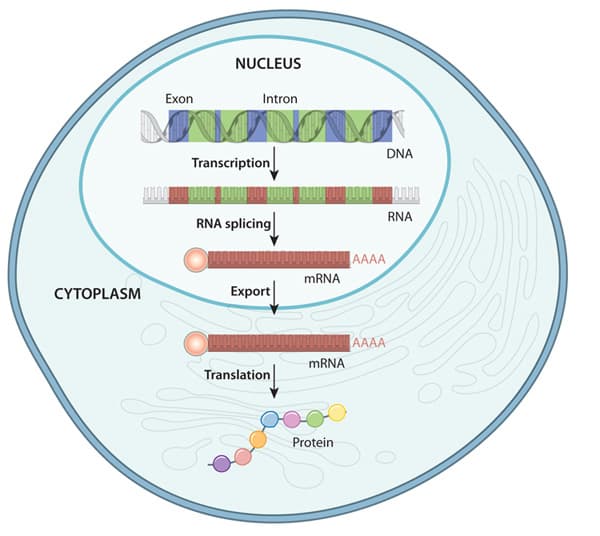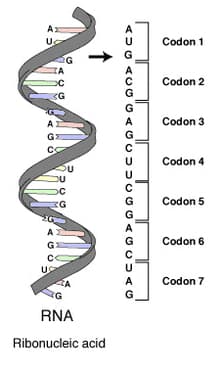The Central Dogma of Biology
The central dogma of biology is the methodical process that the DNA molecule goes through in order to make a protein. It includes the three transitions. The DNA molecule goes through these three transitions in its expression of the encoded message held in the sequence of nucleotides, in this way the message on the DNA molecule is decoded and made into proteins. First, the message on the DNA, or gene, is transcribed or copied to RNA. Then the RNA undergoes processing. This processing involves splicing out non coded regions called introns before the completed messenger RNA (mRNA) molecule is made. Finally, translation of the mRNA occurs resulting in the synthesis of the proteins it is coded to make. 8 (see Figure 5) As a result, DNA is able to express itself through the proteins it ultimately makes.
 9
9
Figure 5 The Central Dogma of Biology
The central dogma is the series of processes that DNA goes through to make the proteins needed for the function of a cell. First, the DNA is transcribed or copied to RNA, then the non-coded areas are spliced out to make mRNA, or messenger RNA. The mRNA leaves the cell and the message it holds in its sequence of bases, or codons is translated into amino acids which build proteins. The proteins then help to build the DNA.
Transcription and Translation
Transcription is the process of copying the DNA molecule to RNA: a section of the DNA (deoxyribonucleic acid) transfers its code from the gene onto an RNA (ribonucleic acid) molecule. The transcription process starts when transcription factors mark the starting location of the gene. RNA polymerase recognizes the starting point and inserts itself between the double helix. Then, an activator protein initiates the process of transcription and the RNA polymerase speeds down the DNA strand, opening the double helix to expose the two strands. However, while the strand is opened, just one of the DNA strands is copied with complimentary bases resulting in the creation of a messenger RNA (mRNA) molecule. In transcription of DNA into RNA, the base adenine pairs with uracil instead of thymine. 10 When the DNA is transcribed, the exact strand is copied. This includes all the exons or coded areas and the introns, or non-coded areas. Next, the RNA molecule is spliced in the nucleus of the cell to remove the introns, or non-coded areas from the RNA.(see Figure 6) As a result, the new mRNA is pure uninterrupted code. The series of codons, or groups of codons are now ready to be translated into chains of amino acids or proteins. (polypeptide.) 11

Figure 6 Processing of DNA into a Protein
DNA goes through a series of processes to make a protein. These processes take place in the nucleus and cytoplasm of the cell. Transcription is the process of DNA being copied to RNA. This process takes place inside the cell nucleus. The sequence of nucleotides on the DNA molecule is transferred to an RNA molecule while in the cell nucleus. The RNA molecule is spliced to remove introns, or non-coded areas. After the RNA is spliced, the mRNA moves out of the cell nucleus into the cytoplasm where it is translated into amino acids by the ribosome and then synthesized into proteins.
Translation
The messenger RNA (mRNA) holds the "message" of the DNA and travels out of the nucleus and into the cytoplasm.( see Figure 6) In the cytoplasm, the mRNA connects to an organelle called a ribosome. The ribosome acts like a protein factory, synthesizing proteins, which means it makes proteins. The ribosome translates each codon on the mRNA into an amino acid. Together these amino acids make a polypeptide chain or protein. This process begins when the mRNA travels through the ribosome "machine," and an amino acid is made from each bundle of three bases, or codon, forming a chain of amino acids. Codons are a group of three bases, or a "word" that name a specific amino acid to be made. (see Figure 7) This chain is made when the amino acids connect to each other after the ribosome reads each codon and translates it into the amino acid it names. The set of codons could also be thought of as the "word" for a specific protein. As the mRNA moves through the ribosomes, it translates the codons into the amino acids. As a result, each codon is translated into a specific amino acid and the message of the gene is expressed. 12

Figure 7 RNA Code for Amino Acids
The RNA molecule carries the codes that build the amino acids in the sequence of its bases. Each bundle of three bases forms a codon. Each codon will be translated at the ribosome for a specific amino acid. The sequence of the codons specify the sequence of amino acids in a polypeptide.( For example below codon 1: methionine (start), codon 2: threonine, codon 3: glutamate)

Comments: